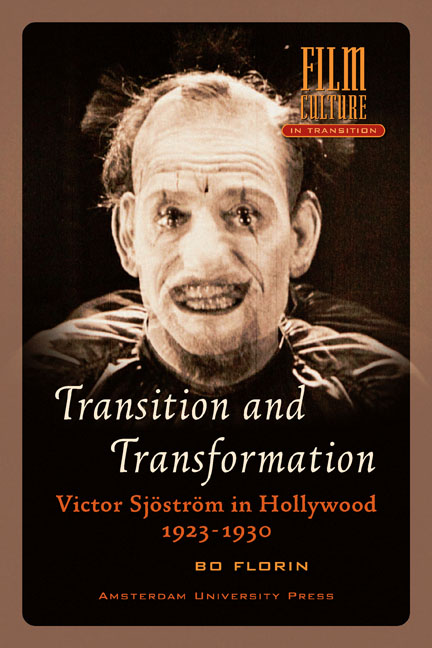Book contents
- Frontmatter
- Contents
- Acknowledgements
- Introduction – From Sjöström to Seastrom
- Sjöström – From National to International
- A European in Hollywood – NAME THE MAN and the Shift of Production Systems
- From Scientist to Clown – HE WHO GETS SLAPPED
- A for Adultery – THE SCARLET LETTER
- Conquering Nature – THE WIND
- Fragmented Pieces – Writing the History of the Lost Hollywood Films
- The Shadow of the Silents – A LADY TO LOVE
- The Genius and the System– Some Concluding Remarks
- Notes
- Bibliography
- Filmography
- Index
- Film Culture in Transition
A European in Hollywood – NAME THE MAN and the Shift of Production Systems
Published online by Cambridge University Press: 22 December 2020
- Frontmatter
- Contents
- Acknowledgements
- Introduction – From Sjöström to Seastrom
- Sjöström – From National to International
- A European in Hollywood – NAME THE MAN and the Shift of Production Systems
- From Scientist to Clown – HE WHO GETS SLAPPED
- A for Adultery – THE SCARLET LETTER
- Conquering Nature – THE WIND
- Fragmented Pieces – Writing the History of the Lost Hollywood Films
- The Shadow of the Silents – A LADY TO LOVE
- The Genius and the System– Some Concluding Remarks
- Notes
- Bibliography
- Filmography
- Index
- Film Culture in Transition
Summary
When Victor Sjöström arrived in Hollywood in 1923, it was, as already mentioned, part of a strategy carefully worked out by Samuel Goldwyn and his fellow producers, to import a number of influential European directors and actors. As the director of a number of films in Sweden which were generally considered as being among the most acclaimed critical and public successes in world cinema, Sjöström was certainly a hot name, well worth acquiring for Hollywood producers. But he and his colleagues would also, had they remained in Europe, become a possible threat to the American hegemony of the market to which Hollywood at this time clearly aspired.
If the previous chapter dealt with how Swedish national cinema might be considered early on also as international, both from a national and an international viewpoint, this chapter will rather deal with the question of American films by European directors – and Sjöström in particular. Their ambiguous status between two production cultures will be discussed in relation to the variations between different practices, and the possible degree of independence that a director like Sjöström might have enjoyed, but also in more detail concerning the stylistic variations taking place in connection with his first Hollywood film NAME THE MAN.
By the time that he left for Hollywood, Sjöström was by far the most renowned director in his home country. He had a unique relationship with Nobel Prize winner Selma Lagerlöf, who had shown the utmost confidence in Sjöström's way of bringing her novels to the screen – a confidence which he, however, had to earn the hard way. As several scholars have shown, Lagerlöf was at first extremely sceptical towards the film medium and its potential, and she also had difficulties in cooperating, e.g. with Mauritz Stiller. Sjöström had worked with novelist Hjalmar Bergman, whom he brought to Hollywood in 1924; after an unsuccessful attempt to write another script for Sjöström, Bergman however went back to Sweden. Sjöström had acted in seven films directed by his colleague Mauritz Stiller, and they had developed a close friendship over the years. Stiller also left Sweden for Hollywood in 1925 together with Greta Garbo and Lars Hanson, who both acted in Hollywood films by Sjöström.
- Type
- Chapter
- Information
- Transition and TransformationVictor Sjöström in Hollywood 1923–1930, pp. 27 - 42Publisher: Amsterdam University PressPrint publication year: 2013



